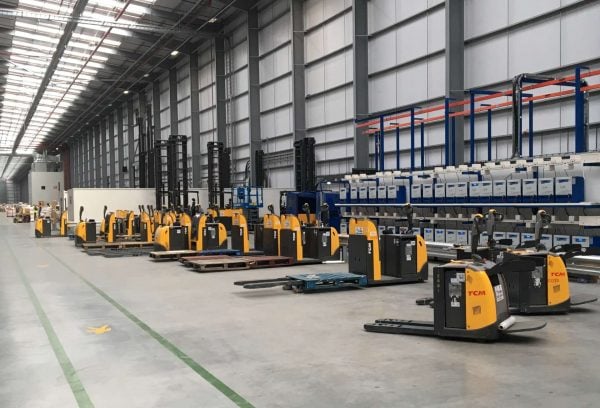Even though the humble pallet jack might be small, it can carry a surprising amount of weight – up to two tonnes in some cases. If it’s an electric pallet jack or ‘walkie’, these can be 300-400kg on top of that. Needless to say, this weight can cause serious injuries if it comes into contact with a pedestrian.
Accidents with manual pallet jacks are most commonly caused by:
- Inattention
- The operator pushing the load too quickly and not being able to stop
- The operator misjudging a manoeuvre, e.g. while turning
- The operator losing control on a slope/ramp.
Accidents with electric pallet jacks are most commonly caused by:
- Inattention
- The operator misjudging a manoeuvre, e.g. while turning
- The pedestrian being obscured
- The operator losing control, e.g. accelerating too quickly
- The operator riding on the machine and slipping off
The best solution is to have strict separation in work areas, but this is rarely practical with pedestrian-operated forklifts because of the nature of their use (i.e. they are used by pedestrians as opposed to be ride-on like a forklift). However, there are ways in which you can reduce the risk.
PPE
All pedestrians should be wearing sufficient and appropriate personal protective equipment such as high-vis clothing so they are readily identifiable by the operator while operating. Steel capped boots are advisable. A hard hat is optional but can be helpful when working with high racks, especially with masted pedestrian-operated pallet jacks that can lift to heights above head height.
Walkways
Keeping non-operator pedestrians to painted walkways is an absolute minimum. Cones and barriers are much better. Operators should be aware of any designated crossings for pedestrians where they might need to stop.

Pedestrians would ideally use a separate entrance.
Visitor education
Part of the induction process for visitors could include a site board with the hazards, a written acknowledgement of the dangers in the workplace and/or either a video or in-person explanation of the hazards.
Visitors should always be accompanied by a company representative.
Warning methods
Electric walkies usually have a horn and the operator should not be afraid to use it if required. The horn should be sounded before rounding a blind corner, going through a doorway or entering an area with radically different light levels (e.g. much darker or much lighter). Operators with a manual pallet jack can call out to make people aware.
Visibility
Operators should always only move the machine in a direction where they can see unless they are using a spotter.
General operating best practices
At crossing points and blind corners, operators must slow down.
In areas where there’s a possibility that the driver may need to perform an emergency stop, pulling the pallet jack is best so that the goods do not slide off the forks.
Operators and pedestrians should not wear headphones. Understandably, some work locations require hearing protection, in which case more stringent policies on visibility and using loud audio warnings must be implemented.
Operators and pedestrians should understand basic hand signals used for indicating directions or intentions.
Pedestrians approaching operators with walkies
Pedestrians should use either hand signals, eye contact or shout out until acknowledged by the operator. The operator must signal the pedestrian when it’s safe to approach. Using an exclusion zone of at least three metres will reduce the risk of a vehicle/pedestrian collision. The walkie should be braked while the operator is talking to a pedestrian and the pedestrian should move out of the exclusion zone before the operator begins to move again.

